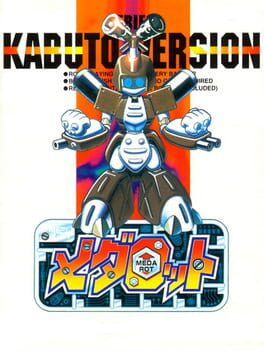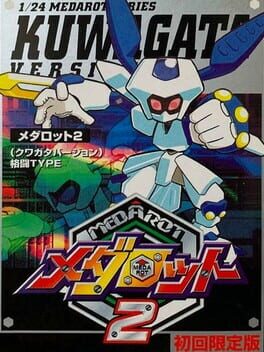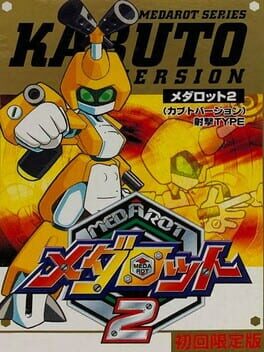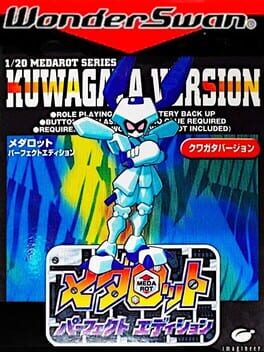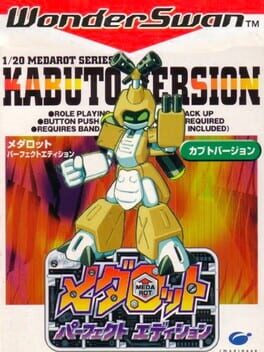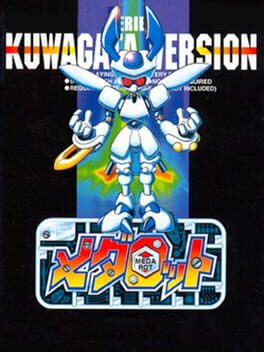

Medarot (also referred to as Medarot 1) is an RPG that was released in 1997 for the Nintendo Game Boy, and the original game that started the Medarot franchise. It follows Hikaru Agata on his quest to compete in Robottle tournaments and defeat the evil Roborobo Gang. Like the other creature-collecting games of the time, Medarot 1 was released in two versions: Kabuto (Rhinoceros beetle), where the player's starting Medarot is Metal Beetle, and Kuwagata (Stag beetle), where the player starts with Head Scissors. Along with the starting Medarots, there are some Medarots and Medals that can only be obtained in a specific version. No English versions of the game were released. Medarot 1 is a monochrome Game Boy game with only basic palette support when played on a Game Boy Color. However, it has a border and more advanced colors when played on a Super Game Boy. A "director's cut" edition of the game titled Medarot Perfect Edition was released for Bandai's Japan-only Wonderswan system in 1999. It had two versions and was also monochrome-only. Later that year, the direct sequel Medarot 2 was released for Game Boy.
Also in series
Reviews View More
but this combat is straight ass and i dont like actually playing this game. i hate to abandon something as cool as this, but i also hate to play it
'Medarot' es otro recolector de monstruos que salieron tras el éxito de la primera generación de 'Pokémon', pero se distingue del resto por su capacidad de personalizar los robots y sus cuatro partes, en pos de obtener el modelo de combate definitivo. Sin embargo, encontrar un equilibrio entre las distintas piezas y la medalla que controla la logística del Tin-Pet (el esqueleto del robot) requiere de mucha paciencia y dobles lecturas que hacer conforme vemos los resultados de nuestras acciones. Sí, hay puntos de experiencia y niveles, pero apenas tienen incidencia en los parámetros que aparecen en pantalla. Para aprender a jugar a 'Medarot' hay que echar cábalas, hacerse preguntas mientras observamos sus combates 3vs3, intuir si la acción que hemos visualizado mejora o no a lo que tenemos. ¿Se ha desplazado el robot más rápido a la línea de combate usando esta pieza? ¿Esta arma es más efectiva contra Medarots con ruedines? ¿A qué enemigo apunta esta otra ¿Tiene sentido usar esto? ¿Lo tiene?
Hoy en día, es posible que haya en Internet alguna guía que explique la matemática detrás de los combates y la progresión de tus Medarots, pero si nos ceñimos exclusivamente a lo que dicta el videojuego cuando salió, hay muy poca información que te diga exactamente lo que tienes que hacer. Cero tutoriales, cero lore que ponga en contexto el mundo de 'Medarot', menús tediosos para acceder a la información deseada, y muy poco equilibrio en general entre el catálogo de piezas disponibles. Pero hay cierta magia en esto de jugar a la vieja usanza, y ver que nuestras órdenes no tienen el peso disciplinario que en otros juegos de monstruitos. Si 'Pokémon' laza un vínculo entre el jugador y sus criaturas por el tiempo que pasamos con ellas dentro y fuera del combate, 'Medarot' es algo más frío y calculador. El vínculo está en el enigma que compone su existencia como arma de destrucción masiva (no tan masiva), consciente de que su única función en la vida es luchar entre ellos sin entender del bien o el mal. Es ver los numeritos de daño, las piezas que se rompen llegado un punto de colapso, verlos moribundos cuando sólo queda el esqueleto y siguen luchando. Son una paradoja de la vida, un contraste con la realidad aparente, una cosa rara de cuidao. Quizá por ello entrañables.
El juego en sí no es gran cosa. Controlamos al típico niño que no tenía Medarots mientras todos sus amigos juegan con los suyos, hasta que el azar le ofreció la posibilidad de tener su propio Medarot súper-ultra-exclusivo y ligeramente superior a los demás. A partir de ahí comienza una aventura que le lleva a través de la ciudad, la playa y las montañas, pero sin un nexo en común que una los puntos. Los personajes vienen, se van, contribuyen muy poco a entender nuestro cometido en la vida, lo único que sabemos es que la banda RoboRobo es muy mala malosa y hay que pararles los pies lo antes posible. Pero nada de lo que sucede resulta muy espectacular o épico siquiera, no hay una gran sensación de peligro, no hay un evento que resulte impactante, todos los problemas se resuelven de la manera más escueta posible. Hay bugs incluso a puntapala, ríete tú de aquellos que les encanta decir lo "bugeados" que estaban Rojo/Azul siendo la primera generación de 'Pokémon'. Sin el apego emocional que pueda tenerse con esta saga (sobre todo viniendo de GBA y el anime que salió en TV), sería algo totalmente prescindible en el catálogo de la pobre Game Boy, menospreciada desde tiempos inmemoriales.
Pero los Medabots molan, así que debe de estar bien. Probablemente mejor en las muchas secuelas que recibió a posteriori, aunque quizá la única que conocemos, en aquel remake protagonizado por Metabee (Kabuto) y Rokusho (Kuwagata), fuese realmente su mayor grado de expresión y su entrega más pulida. Muy difícil de recomendar esta vuelta a los orígenes, más allá de la curiosidad y el carácter histórico de esta primera generación.
First of all, there's the gameplay. The player can bring up to 3 medarot to battles which are fought in a system similar to ATB, only that the legs currently equipped interact with the terrain to alter certain attributes including speed.
On that note, every piece of the medarot can be swapped for a different one and they are divided into 4 parts in total, the only restriction being the gender of the tinpet (frame) of which you can obtain a total of 9. Individual skills have a base value depending on the medal and increase with use overtime as well so there's a very high degree of customization.
This title also innovated upon the monster catching formula by having multiple endings, although the most important change is what girl you end up with. You can end up all alone too so you better do some side quests. That's kind of mundane if you consider all the crazy stuff that happens during the actual plot.
The final positive aspect I want to mention is the music, the main battle theme in particular is extremely catchy and seared into my brain.
However, that brings me to the first issue I had with Medarot, meaning the frequency rate of random encounters. It's way too high in some sections, a common problem for RPGs at the time. The upside is that all your medarot fully heal after battle, but it still gets tedious to fight the same NPCs over and over.
Second, the structure to the story usually consists on an NPC simply telling you where to go next and there are several missables sprinkled through the game, including some really useful items.
And finally, there's no starter selection, you always get the medarot in the box cover. Each version also has some exclusive parts and there's also a third game that's like a parts expansion, but come on. Picking your starter is an iconic aspect of the genre. It generates free word-of-mouth marketing too, but I digress.
In summary, Medarot innovated in some interesting ways upon the monster catching formula first introduced by Pokémon. However, it still suffers from shortcomings that plagued other RPGs at the time of its release. I think it's a good game, but I would recommend the remake of the second game on the Gameboy Advance to start out instead.
Asimismo, te quiero comentar que existe una traducción del primer juego de la franquicia y en el caso de la KBT hay una al español-argentino. El juego tiene su bullshit pero en general es bueno, y muy corto además con tres finales para sacar. Lo que sí, no te recomiendo sacar el 100% porque de lo que leí necesitas las expansiones de parts collection. De todas formas la experiencia standalone vale la pena.
BTW si eres un usuario que no habla español solo te digo que Ñ.
